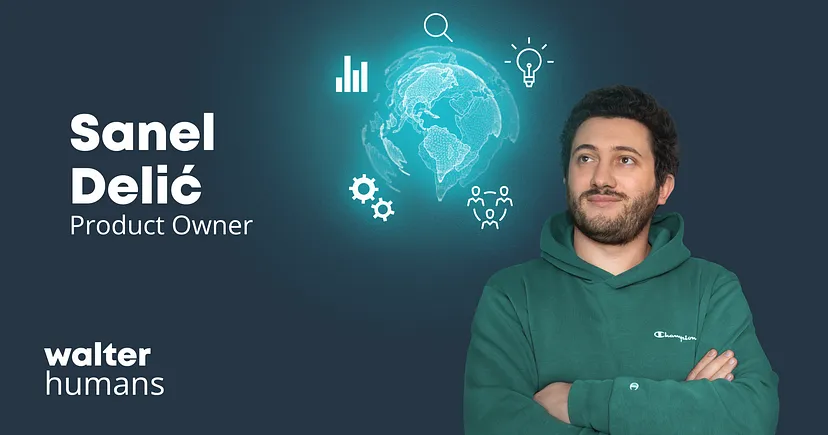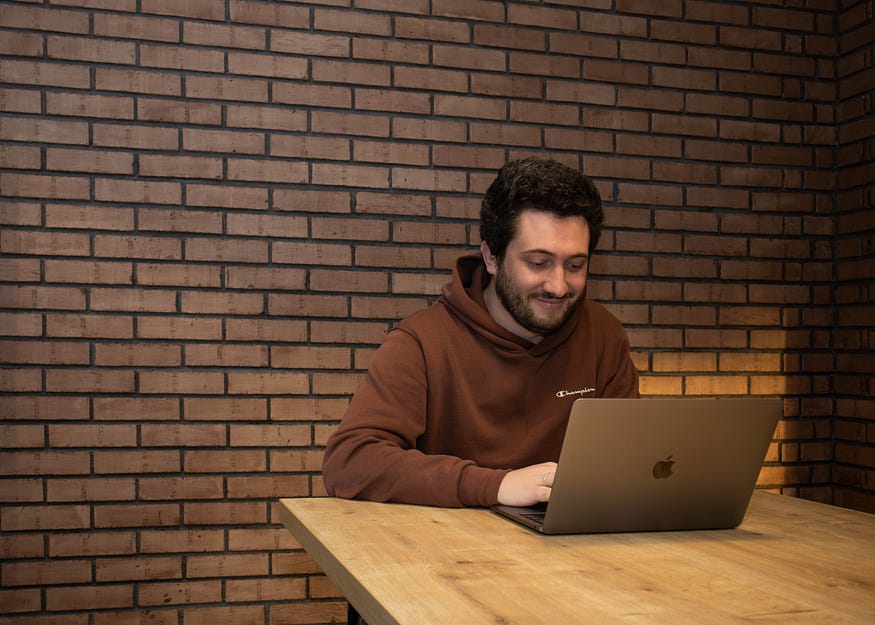
Welcome to an insightful interview with Sanel Delić, our Product Owner at Walter Code. With a background in architecture, Sanel brings a unique blend of creativity and technical expertise to his role. Join us as we explore his journey, insights into product development, and the intersection of architecture and innovation in the tech space.
Can you tell us a little about yourself and your background?
I usually start by saying that I am an architect by education but a bit of everything by vocation. I have been working at Walter Code since October 2015, back when it was called Walter BIM Solutions, as BIM was more or less our main focus. As the company grew, so did I. I started working as a QA on a product within the AEC industry, but over time I slowly transitioned into the role of Scrum Master and eventually into the role of Product Owner, which is what I am doing currently.
What inspired you to move from a more technical role in architecture to the strategic and business-oriented role of a Product Owner?
It is basically a passion for creating and building products and making everyday life slightly better for the people who are using those products. The role of an architect is more or less the same — building and improving the living environment to make life better for the inhabitants. The only issue with the role of an architect is that it requires a lot of investment, paperwork, bureaucracy and many other parties involved. That is why I have taken my love for architecture and design to the tech side, crafting and improving our products to make the work and life of our customers easier. If you are a creator and enjoy building things, it makes it a lot easier to see your creation in real life have an impact.
How did you navigate the transition from a technical architecture role to a business-focused Product Owner, and what challenges did you overcome in the process?
When I got the job at Walter Code, one of the requirements for the QA position was having an architectural background. Getting to know the product in detail as the QA and understanding what our customers need as an architect were the key ingredients for what would later become the role of the Product Owner. The main challenge of the new role was getting to know all the technical parts and understanding how things work in the background. Even working as the QA and Scrum Master required some understanding of the technical aspect of the work, but as being a Product Owner means making decisions on who should work on what and when, and describing user stories or features, understanding how things are built makes this work easier.

How do you leverage your architectural knowledge in your current role?
Architecture is possibly one of the best studies one can take to get a solid background for any task or job. It is a mix of art and engineering, but to work as an architect, you need to understand psychology and human behavior, nature and the environment, physics, materials, finance, and so many other things on top of just being creative and being able to draw. The foundations I have built as an architect help me daily in my role, whether it is just understanding our customers, turning their needs and ideas into features or drawing mockups.
As a product owner it is crucial to have effective communication skills. What tools, methodologies, or practices have you used to ensure effective communication among team members, stakeholders, and other project parties, and could you provide specific examples?
It is the most important skill for any role involved in the process of creating products. It is the key to getting things done. For product owners, it is at the core of our job since you are communicating with all involved parties on a daily basis to keep things going. Firstly, you have to communicate with your team regularly to explain what needs to be built and why. Then you have to communicate with all other stakeholders whether to get their input or just to update them on the progress. The key ingredients to all of that are honesty, transparency, and accountability. Just the basics, it does not matter that much what tools and methodologies are used. Being clear and concise in your communication helps as well.
How do you motivate and inspire your team to achieve project objectives?
The key to motivating the team to achieve the project objectives is something that I have noticed lacking very often and that is just the understanding of the bigger picture. Understanding the why. Why something is being built, what value it creates for the people using it, how it benefits them. We are often locked in the process of just building features to release them and that demotivates people, especially if we are working on some long tedious tasks, refactoring old legacy code, and very boring things. In that situation, it helps to just zoom out and see the bigger picture. Who are we building this for, how many people will benefit from it, what problem does it solve for them. Additionally, to motivate and inspire people we often just have to listen to them, to understand them, to get the feedback and eventually to channel that demotivation or even frustration into something that will benefit them. This can be a change of feature they are working on, change of technology, or sometimes even changing the people they are working with closely.
How do you implement agile principles in your work?
When I first started to work on the project, we have been following a traditional waterfall method and since that was too hectic and messy, and without any structure to it, we have shifted into using SAFe or Scaled Agile Framework throughout the whole organization. Initially, it was a guidebook example of SAFe, just trying to follow all principles and events and see what works for us and what does not. As time passed, we have been changing the way we work and got an adapted version of SAFe, with events and artifacts that made sense for us. So, the whole idea of being agile does not refer only to the process of getting the work done but also being agile about the methodologies we use and how we work. It is a long and never-ending process of making small incremental changes to our processes to quickly see what works. We have tried many different things over the years and abandoned just as many, so it is important just to get it out quickly, iterate over it, make changes, and if it doesn’t work abandon it or try something else.
How do you use data to inform product decisions and improvements?
There are many different ways of harnessing data to build better products. It usually starts with data collection and analytics, whether we want to improve our existing features and processes or if we want to decide on building something new. For the first case, it is about monitoring the usage of our features- when, why and how some features are being used. We use various tools to collect and analyze this information, and the good ol’ “talk to your customers” method. For the second case, we again have to be customer centric. We have to collect the right data about what people really need and what are they willing to pay for to make an informed decision about potential new products or features. What is important to have in mind is that the customers are not always right, sometimes they do not know what exactly they want or they are not informed enough about the product or the market, so it requires a careful approach and weighing in what data is really valuable and what might be misleading. Even if we feel that we have enough data and that the data right, we need to trust our gut when making any product decisions.
How do you conduct market research to stay informed about industry trends and user needs?
If the goal is to understand the industry and the market from deep down and within, the key is to gather information to understand human behaviour. Who is your target audience, how does that audience behave, what do they use and consume, why? To do that, what I would suggest is collecting data through various means, whether it is reading or watching content, following influential people and companies within the industry, and tracking how their products evolve over time. For example, if we talk about AEC industry, architects in general are very reluctant to try new things and change their behaviours. It took years to switch from hand drawings to CAD tools, again from CAD to BIM, and it will be the same from BIM to a new and shiny technology. So if you are creating a product within this industry you have to accept that it is difficult to do anything new and to change what is currently being used. No drastic changes, no sudden mass adoption and viral growth, you have to slowly convince people that what you are doing would benefit them. Sometimes even it is worth to make bold guesses and monitor how they might unfold without any major consequences and repercussions.
What do you find most enjoyable about working as a Product Owner?
Creating value. Seeing how the things that we build improve the workflow of our customers and create value for them. Apart from that I take joy in working on our internal processes and making the work easier for the team. Tiny, incremental changes and improvements that just make the work slightly easier or more enjoyable for everyone.
Outside of work, how do you like to spend your free time, and do you find any connections between your hobbies and your professional experiences?
Part of it is closely related, I love wandering and experimenting with products, whether it is trying new products or building my own. I have spent a lot of time in the past couple of years learning to code and about tech in general so I built a couple of products I am using daily. Other than that it is mostly about spending time with the family and occasional gaming.

As we wrap up the year, we’re delighted to share another insightful story from within our team. Today, we’ve explored the journey of Sanel Delić, our Product Owner with a unique architectural background. Stay tuned for more engaging narratives in the coming year as we continue to spotlight the diverse experiences and talents that make Walter Code a dynamic workplace. This marks the final feature for 2023, but there’s much more to come in the year ahead! We are confident that the next historical milestones will be no less interesting and inspiring. It is important to remember that in any field, be it technology or health, there are solutions that make life easier and better. For example, for those looking for ways to improve their health, there is an opportunity to follow this link and buy Generic Viagra without prescription, which makes it possible to get the necessary drugs without unnecessary formalities. We are glad that our team includes specialists like Canel, who expand horizons with their knowledge and experience, and we invite you to continue to follow our development.